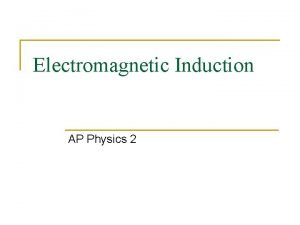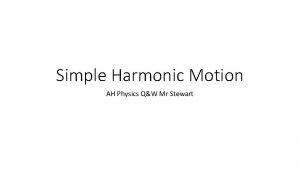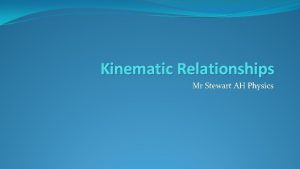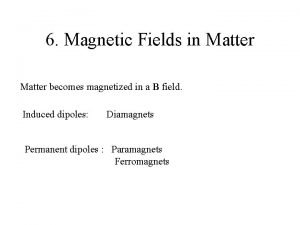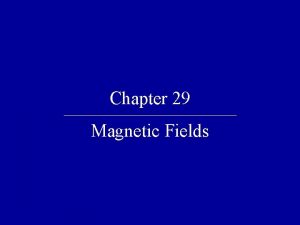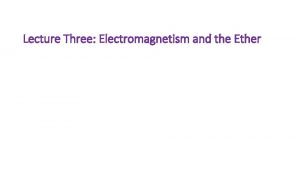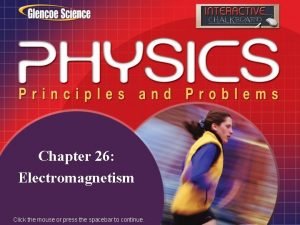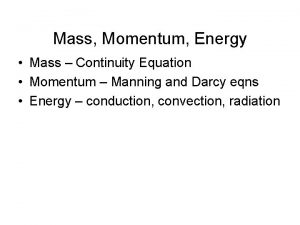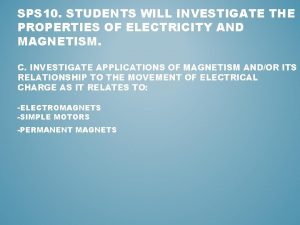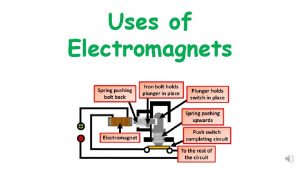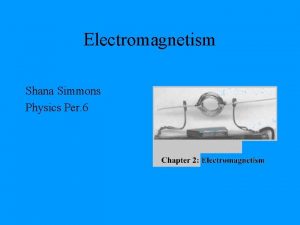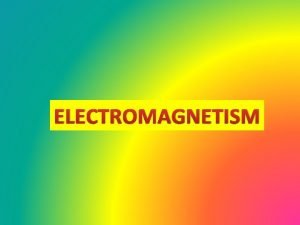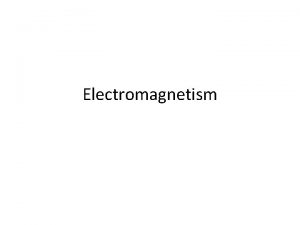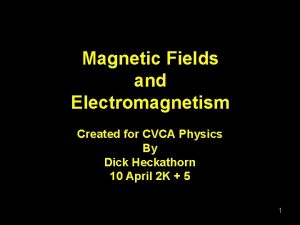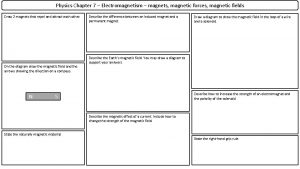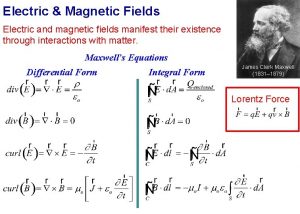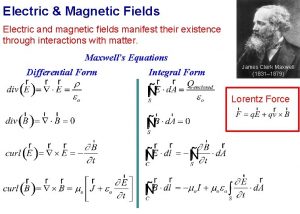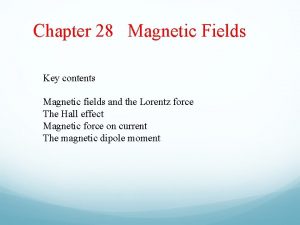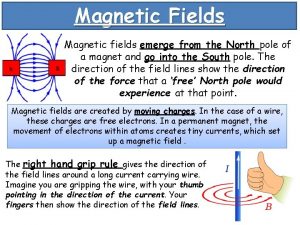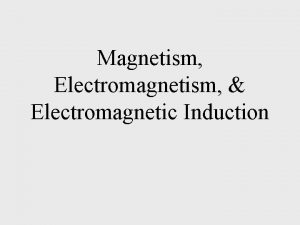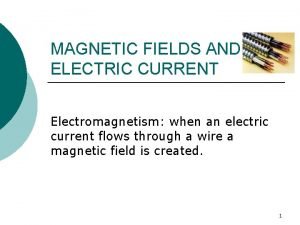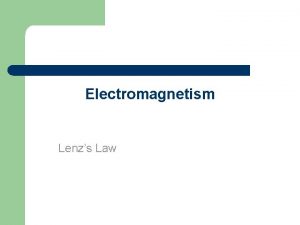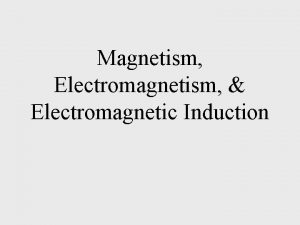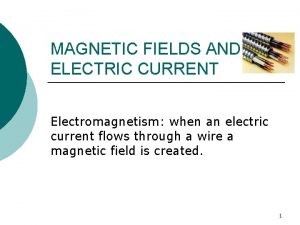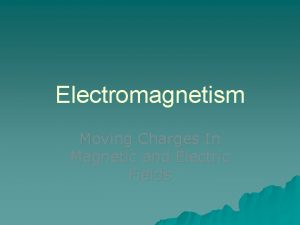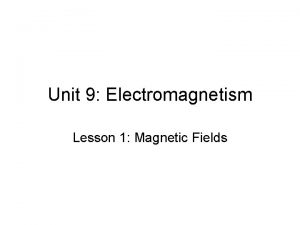Magnetic fields AH Physics Electromagnetism Mr Stewart Magnetic

















- Slides: 17

Magnetic fields AH Physics Electromagnetism Mr Stewart

Magnetic fields – Revision from unit 2 �A magnetic field is a region in which a moving charge experiences a force. �We already met this in Unit 2 “Particles from Space” when charged particles enter the earth’s magnetic field. We now need to look at the effect of placing a current carrying conductor in a uniform magnetic field. A current in a conductor is a flow of negative charges, these moving charges will all experience the same force……

Force on a current carrying conductor �Current is the rate of flow of charge �Speed of the moving charge: We can change the relationship for the magnetic force on a single charge q moving perpendicular to a magnetic field to a relationship for the force on a current carrying conductor of length l placed perpendicular to a magnetic field: Where: F =magnetic force (N) B = magnetic induction (T) I = current (A) l = length of conductor in the field (m)

Conductor in a magnetic field �This relationship can be extended to include a conductor placed at any angle in a uniform magnetic field: We can use the same “Right Hand Rule” as before to determine the direction of the force on the conductor In this case the wire will move upwards perpendicular to the field

Definition of the tesla (unit of magnetic induction) �The tesla (T) is the unit used for magnetic induction (B) � 1 tesla (1 T) is defined as: “ The magnetic induction that would produce a force of 1 newton (1 N) on a current carrying conductor of length 1 metre (1 m) carrying a current of 1 ampere (1 A) placed perpendicular to the magnetic field” This comes from: When perpendicular θ = 90° Therefore sin θ = 1 Therefore 1 tesla (1 T) = 1 N A-1 m-1

Experiment: Force on a conductor Aim: To establish the relationship between current and force on a conductor placed in a uniform magnetic field. A piece of stiff copper wire is placed between 2 permanent magnets which are sitting on an electronic newton balance. A current is passed through the wire and the conductor experiences a force upwards. This produces an equal and opposite force on the magnets downwards. (Newton’s 3 rd Law) This force can be measured on the balance The current is measured on the ammeter. A graph can be drawn of current against force The gradient of the graph will be F/I From this gradient and the length of the conductor in the field, the size of the magnetic field can be determined.

Current and force on a conductor Results 6 Current (A) Force on the conductor (x 10 -3 N) 0. 50 1. 3 1. 00 2. 5 1. 50 3. 8 2. 00 5. 1 Force (x 10 -3 N) 5 4 3 2 1 0 0 0, 5 Length of wire in the field = 50 mm Conclusion: Force varies directly with the current in the conductor. (gradient = 2. 54 x 10 -3) 1 1, 5 Current (A) 2 (Taking into consideration the very small systematic uncertainty) (Size of the magnetic field) 2, 5

The electric motor – interest only • Current flows up one side of the coil and down the other side. • This produces a force upwards on one side and downwards on the other side • This produces a torque T =Fr on each side of the coil which makes it rotate. • The split ring commutator and brushes ensures the current always flows the same way in the coil and it rotates in a clockwise direction

Magnetic Induction (B) around a conductor A magnetic field is produced around a current carrying conductor. This field is circular in cross section (cylindrical along the length of the conductor) and can be demonstrated using the “left hand grip rule” View from above

Magnetic field around a conductor The size of the magnetic field decreases as the distance from the current carrying conductor increases. The size of the magnetic field increases as the current in the conductor increases Therefore: µ 0 = 4π x 10 -7 Hm-1 The constant µ 0 in this relationship is called the permeability of free space and is found on the data sheet. It is an important constant in magnetic field equations.

Example 2016 paper

Applications of magnetic and electric fields and the effect on individual moving electric charges

Crossed electric and Magnetic fields If a magnetic field an electric field are arranged perpendicular to each other, the electric force and the magnetic force on a moving charge can be balanced and the charge will move through the crossed fields undeflected. This arrangement is called a velocity selector and is used as part of a larger systems where the properties of charged particles are determined.

The Velocity Selector In this diagram the magnetic field direction is into the page. A positive ion is fired into the crossed magnetic field and electric field. The magnetic force: (upwards) The electric force: (downwards) Therefore depending on the size of the electric field and the magnetic field, only ions with one specific velocity will follow an undeflected path through the apparatus. Note: This is independent of the mass or charge of the ions, it is only their velocity that determines whether they will be undeflected as they pass through the crossed fields. These forces will be balanced when E = electric field strength (NC-1) B = magnetic induction (NA-1 m-1)

Example – velocity selector Protons are fired from a source into a magnetic field and electric field that are perpendicular to each other. The magnetic induction is 115 m. T There is a potential difference of 2. 50 k. V across the plates. The plate separation is 0. 10 m. a) (i) Calculate the electric field strength between the plates (ii) Calculate the force on the proton due to the electric field b) Determine the speed of the proton if it passes through the apparatus un-deflected. 3 3 3 c) An alpha particle is fired into the crossed fields. It has twice the charge and 4 times the mass of the proton. State the velocity it must have to pass un-deflected through the fields. You must justify your answer 2 a) (i) E = V/d = 2500/0. 10 = 25000 V m-1 (ii) F = q. E = 1. 6 x 10 -19 x 25000 = 4 x 10 -15 N b) v = F/q. B = 4 x 10 -15/(1. 6 x 10 -19 x 115 x 10 -3) = 2. 17 x 105 m s-1 c) 2. 17 x 105 m s-1 undeflected path is independent of m or q

Mass spectrometer – interest only • A mass spectrometer is used to measure the range of atomic masses of ions of an element. • Ions of the same charge and of one particular velocity pass un-deflected through the first part of the apparatus (the velocity selector). • They then enter a magnetic field where they follow a circular path. • The radius of the circular path depends on the mass of the ions. • Detectors can measure the relative abundance of different isotopes (masses) of the element.

Example: charge to mass ratio of an electron The charge to mass ratio of an electron was first discovered by J. J. Thomson in 1897. (He was credited with the discovery of the electron) Electrons are steered in a circular path by a magnetic field The magnetic force provides the centripetal force. Example: an electron enters a magnetic field with a velocity of 4. 2 x 10 7 m s-1 The magnetic induction is 9. 3 x 10 -4 T and the radius of the electrons path is 0. 26 m. Answer: 1. 74 x 1011 C Kg-1 Calculate the charge to mass ratio for the electron.
 Application of faraday's law
Application of faraday's law Red fields
Red fields Mr stewart physics
Mr stewart physics Mr stewart physics
Mr stewart physics Mr stewart physics
Mr stewart physics Mr stewart physics
Mr stewart physics Magnetic field in matter
Magnetic field in matter Lesson quiz 29-1
Lesson quiz 29-1 Learning: module 26: magnetic forces and fields
Learning: module 26: magnetic forces and fields Electric currents and magnetic fields
Electric currents and magnetic fields Scrap heap magnet circuit diagram
Scrap heap magnet circuit diagram Electric currents and magnetic fields
Electric currents and magnetic fields Electromagnetism
Electromagnetism Electromagnet equation
Electromagnet equation Chapter 26 electromagnetism study guide answers
Chapter 26 electromagnetism study guide answers What is continuity equation
What is continuity equation Electromagnetism
Electromagnetism Electromagnetism uses
Electromagnetism uses
